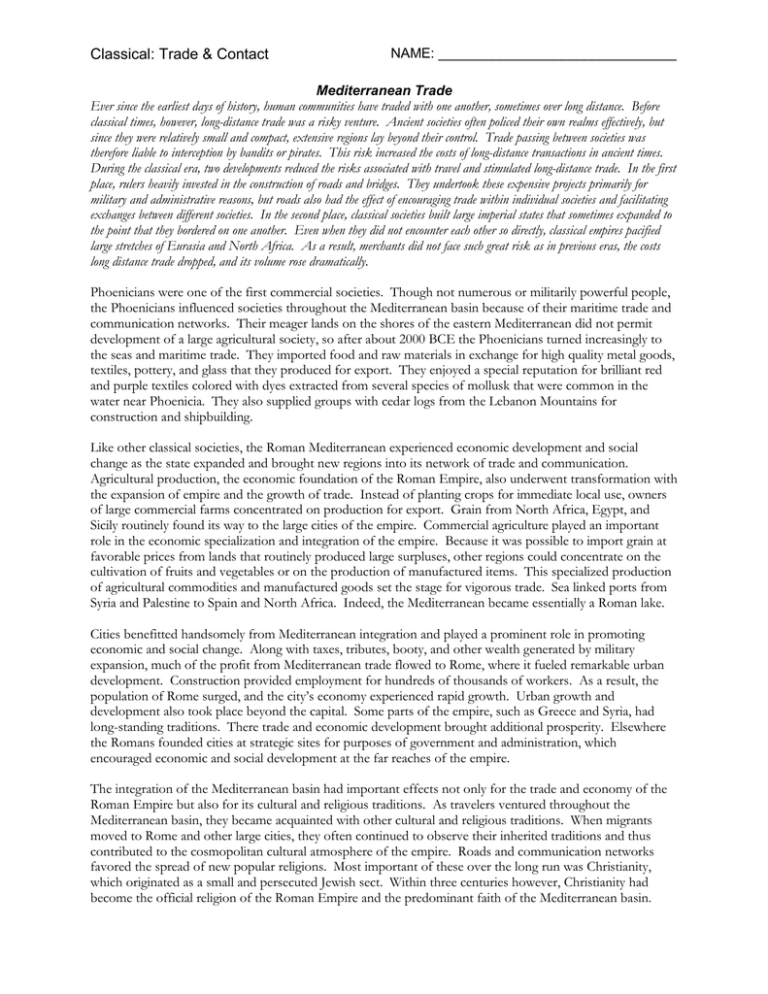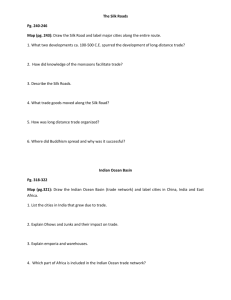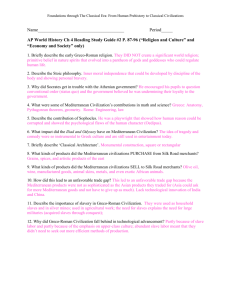Classical: Trade & Contact
advertisement

Classical: Trade & Contact NAME: _______________________________ Mediterranean Trade Ever since the earliest days of history, human communities have traded with one another, sometimes over long distance. Before classical times, however, long-distance trade was a risky venture. Ancient societies often policed their own realms effectively, but since they were relatively small and compact, extensive regions lay beyond their control. Trade passing between societies was therefore liable to interception by bandits or pirates. This risk increased the costs of long-distance transactions in ancient times. During the classical era, two developments reduced the risks associated with travel and stimulated long-distance trade. In the first place, rulers heavily invested in the construction of roads and bridges. They undertook these expensive projects primarily for military and administrative reasons, but roads also had the effect of encouraging trade within individual societies and facilitating exchanges between different societies. In the second place, classical societies built large imperial states that sometimes expanded to the point that they bordered on one another. Even when they did not encounter each other so directly, classical empires pacified large stretches of Eurasia and North Africa. As a result, merchants did not face such great risk as in previous eras, the costs long distance trade dropped, and its volume rose dramatically. Phoenicians were one of the first commercial societies. Though not numerous or militarily powerful people, the Phoenicians influenced societies throughout the Mediterranean basin because of their maritime trade and communication networks. Their meager lands on the shores of the eastern Mediterranean did not permit development of a large agricultural society, so after about 2000 BCE the Phoenicians turned increasingly to the seas and maritime trade. They imported food and raw materials in exchange for high quality metal goods, textiles, pottery, and glass that they produced for export. They enjoyed a special reputation for brilliant red and purple textiles colored with dyes extracted from several species of mollusk that were common in the water near Phoenicia. They also supplied groups with cedar logs from the Lebanon Mountains for construction and shipbuilding. Like other classical societies, the Roman Mediterranean experienced economic development and social change as the state expanded and brought new regions into its network of trade and communication. Agricultural production, the economic foundation of the Roman Empire, also underwent transformation with the expansion of empire and the growth of trade. Instead of planting crops for immediate local use, owners of large commercial farms concentrated on production for export. Grain from North Africa, Egypt, and Sicily routinely found its way to the large cities of the empire. Commercial agriculture played an important role in the economic specialization and integration of the empire. Because it was possible to import grain at favorable prices from lands that routinely produced large surpluses, other regions could concentrate on the cultivation of fruits and vegetables or on the production of manufactured items. This specialized production of agricultural commodities and manufactured goods set the stage for vigorous trade. Sea linked ports from Syria and Palestine to Spain and North Africa. Indeed, the Mediterranean became essentially a Roman lake. Cities benefitted handsomely from Mediterranean integration and played a prominent role in promoting economic and social change. Along with taxes, tributes, booty, and other wealth generated by military expansion, much of the profit from Mediterranean trade flowed to Rome, where it fueled remarkable urban development. Construction provided employment for hundreds of thousands of workers. As a result, the population of Rome surged, and the city’s economy experienced rapid growth. Urban growth and development also took place beyond the capital. Some parts of the empire, such as Greece and Syria, had long-standing traditions. There trade and economic development brought additional prosperity. Elsewhere the Romans founded cities at strategic sites for purposes of government and administration, which encouraged economic and social development at the far reaches of the empire. The integration of the Mediterranean basin had important effects not only for the trade and economy of the Roman Empire but also for its cultural and religious traditions. As travelers ventured throughout the Mediterranean basin, they became acquainted with other cultural and religious traditions. When migrants moved to Rome and other large cities, they often continued to observe their inherited traditions and thus contributed to the cosmopolitan cultural atmosphere of the empire. Roads and communication networks favored the spread of new popular religions. Most important of these over the long run was Christianity, which originated as a small and persecuted Jewish sect. Within three centuries however, Christianity had become the official religion of the Roman Empire and the predominant faith of the Mediterranean basin. Classical: Trade Analysis Indian Ocean Trade Ever since the earliest days of history, human communities have traded with one another, sometimes over long distance. Before classical times, however, long-distance trade was a risky venture. Ancient societies often policed their own realms effectively, but since they were relatively small and compact, extensive regions lay beyond their control. Trade passing between societies was therefore liable to interception by bandits or pirates. This risk increased the costs of long-distance transactions in ancient times. During the classical era, two developments reduced the risks associated with travel and stimulated long-distance trade. In the first place, rulers heavily invested in the construction of roads and bridges. They undertook these expensive projects primarily for military and administrative reasons, but roads also had the effect of encouraging trade within individual societies and facilitating exchanges between different societies. In the second place, classical societies built large imperial states that sometimes expanded to the point that they bordered on one another. Even when they did not encounter each other so directly, classical empires pacified large stretches of Eurasia and North Africa. As a result, merchants did not face such great risk as in previous eras, the costs long distance trade dropped, and its volume rose dramatically. Water travel from the northern tip of the Red Sea southward goes back to the days of the river valley civilizations, with the Ancient Egyptians probably trading with areas along the southern coast of the Arabian Peninsula. Likewise, other shorter water routes had developed in coastal areas around the Indian Ocean. During the classical era, however, these routes connected to one another to form a vast trade network that extended from southeastern China to Africa. By 600 BCE towns dotted the Indian countryside, especially in the northwestern corner of the subcontinent. These towns served the needs of a productive agricultural society by providing manufactured products for local consumption as well as luxury goods such as jewelry destined for the wealthy and elite classes. Demand for manufactured products was very high, and some entrepreneurs organized businesses on a large scale. Flourishing towns maintained marketplaces and encouraged the development of trade. Within the subcontinent itself, trade was most active along the Ganges River, although trade routes also passed through the Ganges delta east to Burma and down the east Indian coast to the Deccan and southern Indian. Roads built by Ashoka also facilitated overland commerce within the subcontinent. Meanwhile, the volume of long-distance trade also grew as large imperial states in China, southwest Asia, and the Mediterranean basin provided a political foundation enabling merchants to deal with their counterparts in distant lands. From India, long-distance trade passed overland in two directions: through the Hindu Kush mountains of northwest India to either Persia and the Mediterranean basin or across central Asia to markets in China. Cotton, aromatics, black pepper, pearls, and gems were the principal Indian exports, in exchange for which Indian merchants imported horses and bullion from western lands and silk from China. During the Mauryan era merchants continued to use land routes, but they increasingly turned to the sea to transport their goods. Seaborne trade benefitted especially from growing knowledge of the monsoon rhythms. Most Indian Ocean traders only traveled back and forth on one of its three legs: 1) southeastern China to Southeast Asia; 2) Southeast Asia to the eastern coast of India; and 3) the western coast of India to the Red Sea and the eastern coast of Africa. As early as the fifth century BCE, Indian merchants had traveled to the islands of Indonesia and the southeast Asian mainland, where they exchanged pearls, cotton, black pepper, and Indian manufactured goods for spices and exotic local products. Many of these goods did not remain in India, but instead traveled west through the Arabian Sea to the lands bordering the Persian Gulf and the Red Sea. Indian products also found markets in the Mediterranean basin. Indian pepper became so popular there that the Roman established direct commercial relations and built several trading settlements in southern India. Archaeologists working in southern India have unearthed hoards of Roman coins that testify to the large volume of trade between classical India and Rome. Classical: Trade Analysis The Silk Road Ever since the earliest days of history, human communities have traded with one another, sometimes over long distance. Before classical times, however, long-distance trade was a risky venture. Ancient societies often policed their own realms effectively, but since they were relatively small and compact, extensive regions lay beyond their control. Trade passing between societies was therefore liable to interception by bandits or pirates. This risk increased the costs of long-distance transactions in ancient times. During the classical era, two developments reduced the risks associated with travel and stimulated long-distance trade. In the first place, rulers heavily invested in the construction of roads and bridges. They undertook these expensive projects primarily for military and administrative reasons, but roads also had the effect of encouraging trade within individual societies and facilitating exchanges between different societies. In the second place, classical societies built large imperial states that sometimes expanded to the point that they bordered on one another. Even when they did not encounter each other so directly, classical empires pacified large stretches of Eurasia and North Africa. As a result, merchants did not face such great risk as in previous eras, the costs long distance trade dropped, and its volume rose dramatically. The Eurasian landmass has long been home to the majority of humankind as well as to the world’s most productive agriculture, largest civilizations, and greatest concentration of pastoral peoples. Beyond its many separate societies and cultures, Eurasia also gave rise to one of the world’s most extensive and sustained networks of exchange among its diverse peoples. Known to scholars as the Silk Roads, a reference to their most famous product, these land-based trade routes linked pastoral and agricultural peoples as well as the large civilizations on the continent’s outer rim. None of its numerous participants knew the full extent of this network’s reach, for it was largely a “relay trade” in which goods were passed down the line, changing hands many times before reaching their final destination. Nonetheless, the Silk Roads provide a certain unity and coherence to Eurasian history alongside the distinct stories of its separate civilizations and peoples. This fabled trade route that extended overland from Xi'an in China to the eastern Mediterranean had its beginnings in the late 2nd century BCE when a Chinese general named Zhang Jian made his way to the Tarim Basin in central Asia on an exploratory journey. There he discovered "heavenly horses" that were far better than any that had been bred in China. The Chinese had many goods to trade, including their highly prized silk, and with the discovery of the horses, they now had something that they wanted in return. The Tarim Basin was connected by trade routes to civilizations to the west, and by 100 BCE Greeks could buy Chinese silk from traders in Mesopotamia, who in turn had traded for the silk with nomads that came from the Tarim Basin. Although the Romans and Chinese probably never actually met, goods made it from one end of the Silk Road to the other, making all people along the route aware of the presence of others. Traders going west from China carried peaches, apricots, cinnamon, ginger, and other spices, as well as the precious silk. Traders going east carried alfalfa (for the horses), grapes, pistachios, sesame, and spinach. Many other goods travelled along parts of the route, so that inventions in any place within access could make their way to other people. The Silk Road was essentially held together by pastoral nomads of Central Asia who supplied animals to transport goods and food and drink needed by the caravan parties. For periodic payments by merchants and bureaucrats, they provided protection from bandits and raiding parties. Of all these luxury goods, it was silk that came to symbolize this Eurasian exchange system. The demand for silk as well as cotton textiles from India was so great in the Roman Empire that various Roman writers were appalled at the drain of resources that it represented. More important even than the economic impact of the Silk Roads was their role as a conduit of culture. Buddhism in particular spread widely throughout Central and East Asia, owing much to the activities of merchants along the Silk Roads. From its beginnings in India during the sixth century B.C.E., Buddhism had appealed to merchants, who preferred its universal message to that of a Brahmin-dominated Hinduism that privileged the higher castes. Indian traders and Buddhist monks, sometimes supported by rulers such as Ashoka, brought the new religion to the trans-Eurasian trade routes. To the west, Persian Zoroastrianism largely blocked the spread of Buddhism, but in the oasis cities of Central Asia, such as Samarkand, Buddhism quickly took hold. By the first century B.C.E., many of the inhabitants of these towns had converted to Buddhism, and foreign merchant communities soon introduced it to northern China as well.





